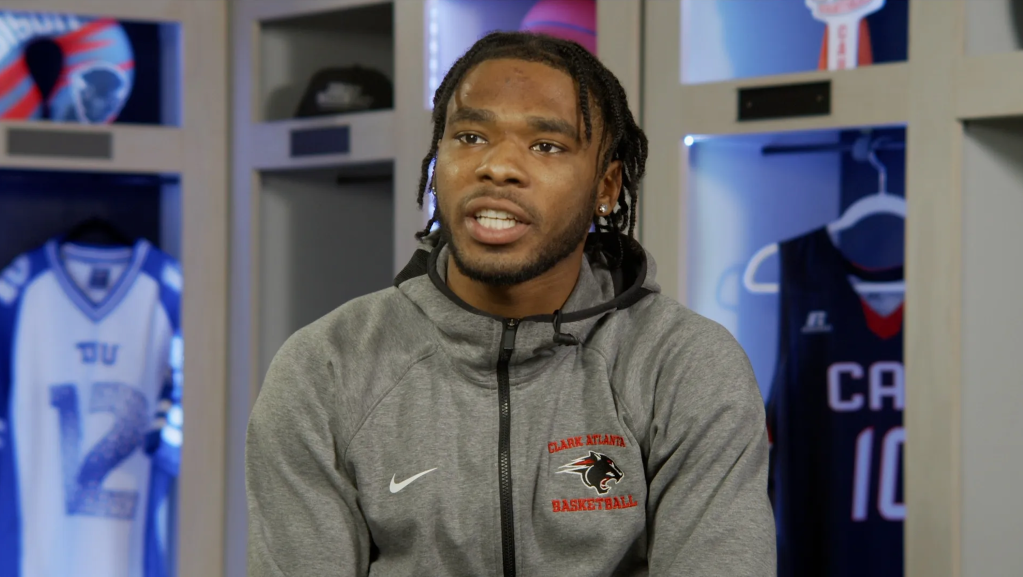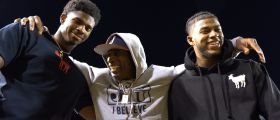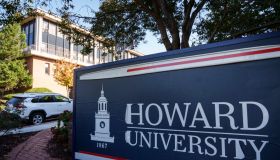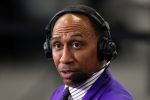
Source: CassiusLife.com / iOne Digital
“Deion Sanders done turned Colorado into a damn HBCU,” comedian Rickey Smiley said on a September episode of The Rickey Smiley Morning Show.
He was joking…kind of.
Ever since Coach Prime landed at the University of Colorado Boulder following a successful run at Jackson State University, the dynamics of their football program have shifted. And it’s not the improvement following a 1-11 season to a 2023 campaign that got off to a promising start when the Buffs upset the previous year’s National Championship runner-up TCU. It’s the entire culture of the football program. With a sold-out stadium to celebrities ranging from Lil Wayne and members of the Wu-Tang Clan to Dwayne “The Rock” Johnson and Anthony Anderson, descending upon lily-white Boulder, Colorado, the football program was turned on its proverbial head.
Although the hype has died down significantly as Colorado has fallen out of the national spotlight due to a series of losses, the fact remains that the world got a glimpse of the program’s potential along with a small taste of what an HBCU could look like on a major platform. And with Colorado becoming an attractive destination for the top Black athletes, it may not be long before the Buffs are knocking at the door to become a Top 25 ranked program. ‘

Source: Head Coach Eddie Robinson, Jr. of the Alabama State, Photo: Don Juan Moore / Getty
“I don’t know if [HBCU football] gets back to what it once was. But I don’t think we’ll go backward”—Alabama State Coach Eddie Robinson Jr.
The cultural phenomenon known as the “Coach Prime Effect” has gone as far as seeing t-shirts with the slogan “H-B-C-U State of mind” with the ‘C-U” in the university’s buffalo logo making waves on the internet as many HBCU students and alumni spoke out against the swift snatching of Black culture. If ever there were a clear example of “they want our rhythm and not our blues,” this would be top five—easy.
Between that and ESPN’s flagship show First Take recently broadcasting from both Winston-Salem State University and Savannah State University, the Historically Black Colleges and University alma maters of Stephen A. Smith and Shannon Sharpe, respectively, college football at HBCUs have had more visibility in recent years than in the past several decades.
Imagine a world where the “Coach Prime Effect” serves as the proverbial tipping point for HBCUs to have access to the best Black college football players in the world. Could there be a universe where the #1 pick in the NFL draft comes out of Howard University?
Although people under 30 may scoff at the idea, there was a time when HBCUs produced plenty of NFL players, with a significant amount wearing gold jackets. Is it possible that Coach Prime has opened the faucet that could eventually create a flood of four and five-star recruits taking their talents to Grambling State or Florida A&M?
“I don’t know if [HBCU football] will get back to what it once was,” said Alabama State coach Eddie Robinson Jr., who played linebacker himself at Alabama State University in the 1990s.
Still, he acknowledges that Deion Sanders may have sparked a movement where HBCUs will once again become an attractive destination for the country’s top Black athletes.
“I don’t think we’ll go backward, which is the biggest thing,” Robinson Jr. said. “You want to keep having this growth from year to year.”
SEPARATE BUT EQUAL
It wasn’t too long ago that African-American athletes didn’t have the opportunity to play football at universities such as Alabama, Georgia, Michigan and Miami due to segregation. Instead, the most talented African-American athletes had to play football for historically Black schools.
Over 30 NFL Hall of Famers have come from HBCUs—a star-studded list that includes the likes of Walter Payton, Jerry Rice, Deacon Jones, Art Shell, and Mel Blount. They crushed racial barriers and ideology that suggested that they weren’t good enough for the big time.
But then, in the mid-1950s, desegregation and changing political attitudes caused a seismic shift in opportunities for African Americans to attend some of the bigger, well-known universities.
During this decade, the NCAA also began securing broadcasting rights—a major source of revenue for colleges and universities. HBCU’s, unfortunately, but unsurprisingly, were excluded from those broadcasting and money-making opportunities. And with collegiate sports being such a significant part of a university’s ability to acquire funding, HBCUs found themselves being less and less desirable to high school kids with professional sports dreams.
In a tale as old as Jim Crow, integration supposedly led to equality, but it did not lead to an equitable distribution of talent as some Black athletes eagerly assimilated into spaces in which they had previously not been allowed.
Though these changes were inevitable, they were not immediate. Racial segregation was declared unconstitutional in 1954 and James Meredith became the first African American student to enroll in a non-HBCU in 1962. Still, it would take decades before integration would take hold and strip HBCUs of having a hold on top tier Black athletes.
Whether that was due to legacy students breaking the chain, broadcasting rights deals making PWIs more visible and desirable, or a polarizing mix of the above, it was a process that eventually dried up HBCUs of the recruiting power they once had.
“Integration is definitely the reason HBCU programs aren’t producing the talent they once did,” ESPN journalist and Hampton University graduate Justin Tinsley says. “Once we started saying that the best Black athletes have access to the big schools and the big schools have the prestige, the TV rights deals and resources that HBCUs don’t have. When you compete for resources that you don’t have, you aren’t able to compete for the best talent to attend (HBCUs).”
The other downside of desegregation was that HBCUs no longer had a de facto monopoly over Black athletes and the expectation of having the best Black athletes at their universities began to dissipate. In a similar fashion to what happened to the Negro Leagues once Jackie Robinson broke the color barrier in Major League Baseball, the quality of the games diminished until HBCUs were virtually ignored by the mainstream.
“I don’t think that he did anything that would scar HBCUs forever but I also don’t think that he put it in a place where the fabric of HBCU football will forever be different.”—Justin Tinsley, ESPN
THE AFTERMATH OF INTEGRATION
Although the presence of HBCU football players in the NFL today is not nearly as significant as it was a half-decade ago with 420 HBCU players drafted into the NFL in the 1970s compared to only 51 in the 2000s, there have been some success stories.

Source: Ramon Harewood #70 of the Baltimore Ravens, Photo: Peter G. Aiken / Getty
Morehouse alum Ramon Harewood was drafted by the Baltimore Ravens in 2010 and was the starting left guard during their 2012 Super Bowl championship season. But even though he would end up in the NFL, Saturdays at B.T. Harvey Stadium in Atlanta were more about the social gatherings than anything that happened on the field during his college game days.
“We played many games with no more than 500 people in the stands,” Harewood reflects. Born and raised in Barbados, Harewood had no intentions on playing football in college and attended Morehouse on a track scholarship, and focused on his studies as a physics major. But when the head coach asked him to try his hand at football, Harewood accepted the challenge and excelled. By his junior year, scouts were frequenting the team practices.
“It was hard to get excited (about a future in the NFL) coming from a place like Morehouse,” Harewood says. “It’s not done often so all my expectations and emotions were tempered.”
Overall, the number of players drafted to the NFL from an HBCU had seen a year-over-year decrease in the 2000s. The games, always family affairs for students and alumni, sometimes resembled more of a party atmosphere than an athletic competition, with the exception of such storied rivalries as Grambling vs. Southern (the Bayou Classic), FAMU vs. Bethune-Cookman (the Florida Classic), and Alcorn State vs. Jackson State (the Soul Bowl).
But in 2020, HBCUs had the spotlight when NFL Hall of Famer and one of the most electrifying, and polarizing, personalities in all of sports, Deion Sanders, accepted a job as the head coach of the Jackson State Tigers. The sporting world at large turned their attention to Sanders’ first major coaching gig.
In just his second season, Sanders led the Tigers to a program record of 11 wins while also being named as the recipient of the 2021 Eddie Robinson Award (the famed Grambling State head coach is no relation to Alabama coach Eddie Robinson Jr.) as the season’s top FCS head coach. All eyes were on Sanders and, by proxy, HBCUs. A docuseries titled Coach Prime followed Sanders and Jackson State from 2021 to 2022.
But after just three seasons at Jackson State, Coach Prime accepted a lucrative five-year contract, reportedly worth $30 million, to become the head coach of Colorado.
“Sanders put a huge spotlight on HBCU football, he generated big revenues for Jackson State, laid down the law with his players for off-the-field matters like few coaches can, stressed academics, delivered hope, established long-term plans and provided impetus for upgraded facilities,” USA Today writer Jarrett Bell said about Sanders’ impact following his departure in a December 2022 story.
Although there has been a significant amount of dialogue surrounding Sanders using an HBCU for personal gain, Harewood believes that Coach Prime’s tenure had run its course and he had to make his next move when the opportunity presented itself.
“I don’t see one negative thing from his tenure,” Harewood says. “He would have been wasted if he stayed.”
Tinsley doesn’t necessarily see a positive or a negative in Coach Prime’s tenure and subsequent decision.
“I think the answer is neither,” he says. “I don’t think that he did anything that would scar HBCUs forever but I also don’t think that he put it in a place where the fabric of HBCU football will forever be different.”
It must be said that Sanders is a unicorn in this scenario where a Power 5 school would be eager to sign a lucrative deal with an HBCU coach. But not everyone is Deion Sanders. Very few people in the world will come within striking distance of his notoriety and ability to be a mainstream attraction all while proving to be a competent coach that motivates his players. His first stop at an HBCU during his collegiate coaching career was, objectively, a personal success, and arguably, a collective one as it has opened a window for the world to see that HBCU football is more than a game.
Ultimately, most have come to the same conclusion that Deion Sanders did what was best for Deion Sanders. And if that helped elevate the visibility of HBCU football, albeit briefly, then his rising tide did lift all boats—even if his departure, some believe, punctured the sails.
“MUST BE THE MONEY” — AND THE NIL DEALS
“This is the guy who made a song called ‘Must be the Money,’” Tinsley explains. “So you know what he’s going to follow but that also doesn’t make him a bad person. It makes him a human.”
While Coach Prime’s brief tenure raised eyebrows, the truth is that the unprecedented decision that the number one overall high school recruit made on December 15, 2021, may end up being the true tipping point for HBCUs.
Collins Hill High School cornerback and wide receiver Travis Hunter Jr. received a scholarship from Florida State in 2019 and committed to the Seminoles in March 2020 after being heavily recruited by college football powerhouses Alabama, Auburn, Georgia, Michigan and Oklahoma, amongst others. But in what has been billed as “probably the most shocking decision in the history of college football recruiting” by Sports Illustrated, Hunter flipped his commitment to Jackson State and became the first five-star recruit to ever sign with an HBCU. And now that the domino has fallen, there is an expectation that other top recruits will begin considering HBCUs for their collegiate football career.
“Nobody wants to be the first one to be that guy but once you see somebody else doing it you get the three and four-star athletes to say that going to an HBCU is a legitimate option because Travis Hunter did it, he did well while there and he still has a chance to get to the NFL,” Robinson Jr. says.
Coach Prime played a significant role in causing Hunter to flip his commitment from Florida State to Jackson State due to his status as one of the greatest defensive backs in the history of the NFL as well as his commitment to allow the top recruit to play both sides of the ball, something other colleges weren’t interested in granting.
Of course, Coach Prime, Hunter and Sanders’ son Shedeur have since taken their talents to Colorado. Some may argue that Sanders had to leave for the opportunity or his talents would have been wasted if he stayed at JSU. But how, then, can the argument credibly be made that the “Coach Prime Effect” will be an influx of athletes into HBCUs, rather than an exodus away from them?
Yes, there has been plenty of conversation surrounding the idea that Sanders “used” Jackson State as a launchpad to land a coaching job at a Power Five conference (ACC, Big Ten, Big 12, Pac-12 and SEC), but the shrapnel from the duo’s explosive decision has left a trail of money that other athletes can follow when it comes to deciding whether or not an HBCU would be beneficial to the dreams of playing pro football.
In William C. Rhoden’s book Forty Million Dollar Slaves, there is a chapter that inquires about what would have been a seismic shift in collegiate sports if Michigan’s 1991 recruiting class of Chris Webber, Jalen Rose, Juwan Howard, Jimmy King and Ray Jackson—famously known as The Fab Five—committed to an HBCU instead of a Predominantly White Institution (PWI). Webber, the top recruit at the time who would go on to have an excellent NBA career, was chronicled explaining that The Fab Five were encouraged to sign with an HBCU but ultimately decided against it because “we had to do what was best for us at the time.”
The idea of “what was best” had a lot to do with resources and money, something HBCUs didn’t have enough of to entice four and five-star athletes. But the 2021 decision by the NCAA to allow players to make money off of their name, image or likeness (NIL) has opened the door for athletes to have the flexibility to pick a college of their liking and not be restricted to a PWI due to financial concerns.
Carolina Panthers rookie quarterback Bryce Young reportedly made $3.5 million in NIL deals during his tenure at Alabama. On3 has projected Shedeur Sanders to have a $4.8 million NIL valuation, the highest in college football.
NIL means that college athletes don’t have to wait to get to the NFL to earn life-altering income and they could choose the HBCU experience instead of being forced to play for a PWI for their resources.
The opportunity for an HBCU college football powerhouse isn’t outside the realm of possibility. “I think (a Fab Five situation) can happen now because of NIL,” Robinson says. “Before it could never happen because the reality is that we don’t have enough donors with the type of generational wealth that the PWIs have to give that type of money. And back then they were literally giving it to athletes under the table
“If you have an NIL group that says they want five-star basketball players to go to Howard for one year, make the NCAA tournament and upset some teams, that means these kids can get the same experience at Howard in one year that they could get at North Carolina or Duke.”
While Robinson thinks it can happen, he’s not sure if it will. The fact the idea exists is significant and is a beacon of light for the future of HBCU football.
“These kids are coming into school understanding branding, marketing and self-promotion,” Tinsley says. “NIL deals will give HBCU’s access to more top-level talent and that will change the game more than any one person will.”
While the game may continue to grow and evolve with more opportunities for rising HBCU athletic stars, the brilliant, beautiful, Black culture that students can only become immersed in at an HBCU—regardless of surface level attempts to replicate it—can neither be sold nor bought.
It’s a new day. Let the games begin.



















